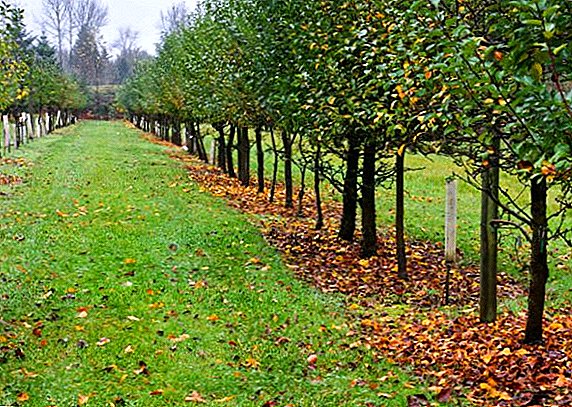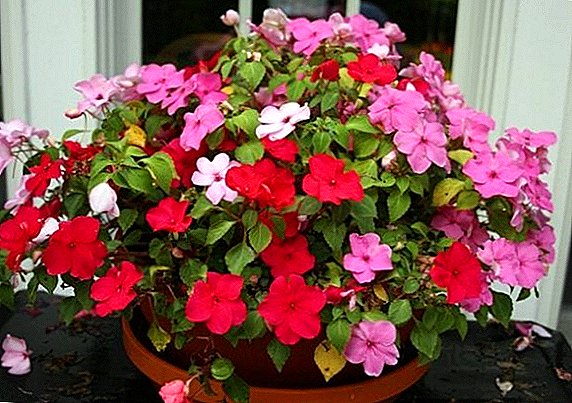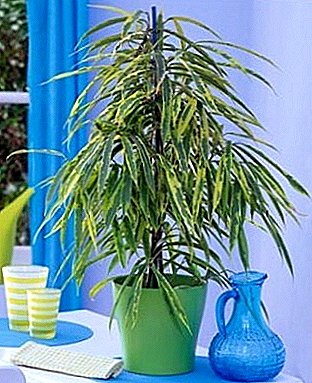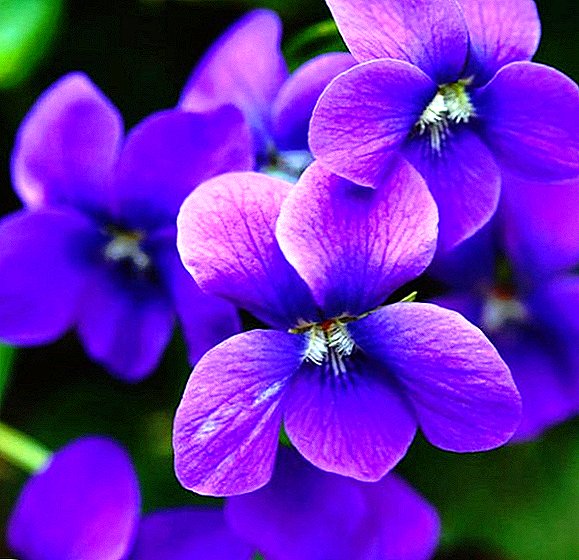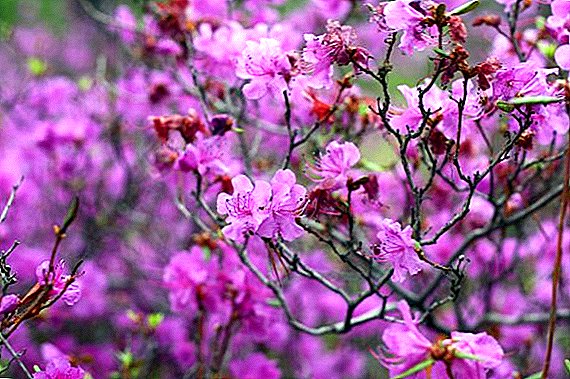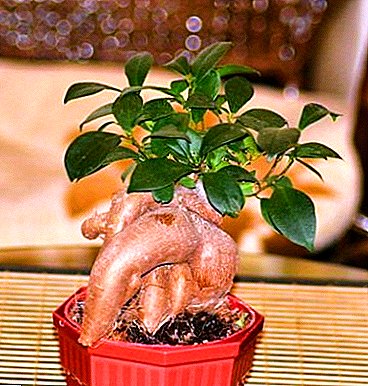
Ficus Microcarp is a spectacular indoor plant, serves as an excellent interior decoration.
When growing it at home, you should follow some rules.
Description of the species
His homeland is Southeast Asia. The growth of this plant in nature 20-25 meters. Its feature is a thin, smooth trunk and a lush, dark green crown. The scientific name is Ficus microcarpa.
It got its name due to miniature fruits appearing on it in the wild. At home, neither flowering nor fruit will not succeed, since there are no conditions for its pollination.
In indoor floriculture is grown most often in the style of Bonsai. This miniature tree is, in fact, a copy of an Asian relative.
The plant has lanceolate, wide leaves, smooth in texture, on short petioles. The surface of the leaves as if waxed.
When flowering, like all members of the family, forms spherical, purple, small inflorescences (syconia). They are more like berries.
Benefit and harm
 It has long been believed that the ficus helps to maintain comfort in the home and stability in family life.
It has long been believed that the ficus helps to maintain comfort in the home and stability in family life.
Its leaves purify the air, absorbing harmful substances.
At the same time, he has also harmful properties.
Juice released when cutting shoots can cause allergies and skin irritation. Therefore, all manipulations are advised to carry gloves.
Home care
Growing this type of Bonsai style, it is given a special form, consisting of a fancy interweaving of roots. They are located above the pot and look like a sculptural statue, decorated with a thick crown.
But in order to grow such beauty, the florist will have to follow some rules.
Immediately give him a place where he will be kept constantly. It should be light, but without direct sun, protected from drafts.
The first two weeks in the house - a period of adaptation to new conditions. Ficus can throw off the leaves, but it's not scary. From the shipping container it needs to be transplanted, but only after 3 weeks.
Spraying start immediately after purchase, and postpone watering for two days.
A photo
In the photo ficus "Microcarp":




Regular transplant he needs. Do it once every two, three years.
Replace annually there is no need, but recommended partial replacement of the soil. Transfer to a new container is carried out together with the old substrate.
The exception is the transplant after purchase. The substrate in which the plants are sold is not suitable for long-term cultivation and is completely replaced.
Before the procedure, the plant is not watered so that the roots are easier to clean. A layer of drainage is poured into a new container, then ficus soil. The mixture can be purchased ready-made, special.
If this is not possible, make it yourself from equal sod, sand and peat.
To maintain low acidity, charcoal is added to the composition.
In the center of the pot or slightly displacing, put a tree and cover the empty space with soil. Compact it by tapping lightly on the container.
The size of the pot should be 3-4 centimeters larger than the previous one. If you do not want the ficus to grow in size, you can not change the dishes, but only replace the soil mixture.
Features of the soil composition
 The composition is selected depending on age.
The composition is selected depending on age.
- For young soil should be as loose as possible:
- Sheet sod - 1h.
- Sand-1h.
- Peat - 1h.
- Wood ash - 0.5 h.
- Adults need a denser composition:
- Leafy ground - 2 hours
- Sod - 2 h.
- Sand - 1 hour
- Humus - 1 hour
- Wood ash - 0.5 h.
After how much water the ficus "Microcarp"?
Drying the soil can not be allowed, water the ficus regularly. Water applied is soft, room temperature.
Check the condition of the soil with your finger, putting it in the pot. Sticking soil suggests that watering is not necessary.
When watering earthy clod should soak completely. Water should flow into the pan, then it is drained.
IMPORTANT: Do not overmoisten the soil, the roots of this rot.
Temperature
The optimum air temperature is 25-30 degrees. Main condition - Do not lower the temperature below 16. And the air should be warm, and the soil. In winter, the ficus may overcool on a windowsill or a cold floor and die. To prevent this from happening, do not hold it near cold glasses and do not put it on the floor.
Air humidity
Abundant moisture is not required, it is enough to maintain the level of 50-60%. However, on hot summer days and in winter, during heating operation, humidity is reduced to 30-40%.
Solve the problem helps frequent spraying, the use of a humidifier, decorative fountains.
Fertilizers
 Top dressing is a necessary condition for growing.
Top dressing is a necessary condition for growing.
Fertilize Microcarp from spring to autumn.
You can apply a universal fertilizer for leaf plants or a special fertilizer for bonsai.
The frequency of the procedure is once every two weeks.
During the rest period - November-February - it is enough to fertilize every 30-40 days.
Useful foliar feedings.
The procedure is combined with spraying once every 2-3 weeks.
The concentration of mineral substances, with this method, should be several times less (carefully read the recommendations on the package).
ATTENTION: Apply top dressing only in wet soil so that the roots are not injured and the nutrients are completely absorbed.
Breeding
Reproduction is carried out in the following ways:
Cuttings
Cut off the apical. Semi-woody shoots. To remove the milky juice stand day in water. Then rooted in a glass of warm water.
To prevent rotting into the water is added a little wood ash.
After the appearance of the roots, the stalk is planted in a pot under a transparent cap until the leaves appear.
Cultivating slips
Layers can be grown on a specimen obtained by cutting.
For reproduction Microcarp with a characteristic appearance of this method is not acceptable.
To get otvodkaotupa from the crown 50-60 cm, cut off the bark from the trunk (10-12 cm) and wrap the cut moistened with moss and film.
On this place in a month roots form. Then the top of the head is cut and put in a separate container.
Sowing seeds
 Only by the seed method can one grow a specimen with a characteristic sculptural root.
Only by the seed method can one grow a specimen with a characteristic sculptural root.
Seed propagation is carried out in the spring. First of all, you should purchase high-quality planting material at the point of sale where the conditions for storing the goods are created.
If the seeds were stored incorrectly, they will not grow.
Sowing of moist and stratified seeds is produced in a flat container. At the bottom lay a layer of drainage, then a layer of soil.
The surface is tamped, moistened, laid out the seeds on it.
Then the crops are sprinkled with a small layer of sand and covered with glass or transparent film.
For germination crops need sufficient illumination and heat (22-250С).
Depending on the quality and conditions of the material sprouts appear in 2-4 weeks. In the phase of two true leaflets sprout dive.
During the rearing is carried out regular spraying.
New instances are seated in separate containers no earlier than 60 days after the pick.
Ficus "Microcarp": how to form a crown?
Regular pruning is a necessary condition for getting beautiful ficus. It is held in spring or autumn, at the beginning or end of the growing season, respectively.
To the trunk of the tree was powerful, you need to often and strongly cut young plants. When pruning, remove a lot of leaves.
Branches can be formed by directing in the right direction with the help of wire.
Shoots are shortened when they are longer than 20 centimeters. To obtain a branched crown shoots longer than five centimeters pinch.
This will promote the growth of the lower buds and the crown will become lush.
In order for Microcarp to appear ornamental thickened roots, a specimen grown from seeds must be cut.
In this case, the trunk is cut off to the root collar, leave a stub of 2-3 centimeters long.
The roots are washed and divided, then each is planted so that the main part is above the soil level.
For the appearance of foliage using stimulants.
On large roots, grafting of cuttings is possible to obtain a spectacular crown of complicated shape.
Diseases and pests
With improper care ficus may suffer from the following problems:
 Dark spots on the leaves - consequence of waterlogging.
Dark spots on the leaves - consequence of waterlogging.
Fusarium - root decay. At the same time they darken, become hollow inside, soft. The reason is wet and cold soil.
Leaf Reset - dryness and high air temperature, insufficient watering.
The appearance of white bloom. White cobweb on the leaves - infection with spider mites. In this case, wipe the leaves with a cotton swab dipped in a solution of alcohol or laundry soap and treat with insecticide.
Points and spots on the leaves - the appearance of aphids. Her breeding helps dry and too warm air. You can destroy aphids by bathing the plant in a soap or tobacco solution.
Why do ficus "Microcarp" fall leaves? What to do?
Yellowing of the leaves can occur for various reasons.
Natural extinction. In this case, the phenomenon is unique and there is no need to fight it.
Change of conditions of detention. If the ficus "Mikrokarpa" fall green leaves, it means that when you rearrange or transplant the plant has experienced stress.
Move the plant to its original place and do not move it unnecessarily.
Wrong soil or crockery. The soil could be infected, and a virus got into the roots of the plant when it was transplanted.
Treat it with fungicides. Also, the cause could be too spacious pot.
Lack or excess of lighting. A window that is too dark or a direct sunlight on the ficus can cause yellow leaves.
Freezing roots. In winter, when the content of ficus on a window or a cold floor is sharply reduced, the temperature of the soil, and the ficus will freeze. Do not hold it near cold glass.
If you grow ficus on the floor. For the winter, put a felt, foam or several layers of newspapers under the pot.
The appearance of pests. Insects settling on leaves and stalks suck the sap from the tissues and they die off.
Carefully examine your pet with a magnifying glass, since the pests are very small and it is difficult to spot them with the naked eye.
From the experience of florist
 Do not water the ficus immediately after transplanting - let it adapt a couple of days.
Do not water the ficus immediately after transplanting - let it adapt a couple of days.
When spraying and watering do not get on the trunk - it will cause it to rot.
In winter, make sure that the leaves do not touch the ice glass, otherwise there will be a local frostbite.
When airing ficus should not fall under the stream of cold air.
Hot air from the batteries is also harmful to him.
Ficus Microcarp is an ideal indoor plant. Caring for him is simple, and with proper pruning you can create a beautiful, original tree that serves as an original detail of the interior of the apartment.



